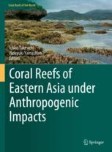Search
Search Results
-
Large-scale biogeographic patterns are reflected in the genetic structure of a broadcast spawning stony coral
Countries in the Western Indian Ocean (WIO) and along the Red Sea are particularly vulnerable to coral reef degradation, and understanding the degree...

-
The coral pathogen Vibrio coralliilyticus kills non-pathogenic holobiont competitors by triggering prophage induction
The coral reef microbiome is central to reef health and resilience. Competitive interactions between opportunistic coral pathogens and other...

-
Finding signals in the noise of coral recruitment
Measurements of coral recruitment can improve understanding of coral population dynamics, but in short duration studies high variance impedes...

-
Impacts of nursery-based propagation and out-planting on coral-associated bacterial communities
Efforts to manage coral reef declines are increasingly turning towards in situ propagation of corals to aid reef recovery. Understanding the factors...

-
Induction of Staghorn coral settlement and early post-settlement survival in laboratory conditions
Acropora cervicornis have suffered massive mortalities in the Caribbean, and decades later are yet to recover. Coral recruitment through larval...

-
Succession and Emergence of Corals in High-Latitude (Temperate) Areas of Eastern Asia into the Future
High-latitude areas have been hypothesized as potential refugia in the future for those corals which can range-shift across the latitudes (from...
-
Pre-exposure to a variable temperature treatment improves the response of Acropora cervicornis to acute thermal stress
Given that global warming is the greatest threat to coral reefs, coral restoration projects have expanded worldwide with the goal of replenishing...

-
Neighboring colonies influence uptake of thermotolerant endosymbionts in threatened Caribbean coral recruits
Intervention strategies to enhance coral resilience include manipulating associations with algal endosymbionts. While hosting thermotolerant Durusdiniu...

-
Population dynamics and genotypic richness of threatened Acropora species and their hybrid in the U.S. Virgin Islands
Acropora cervicornis and A. palmata have experienced substantial losses in coral cover throughout the Caribbean, but their hybrid ( A. prolifera )...

-
Coral Reef Management in the Arabian Seas
Coral reefs in the Arabian Seas exist in and are resilient to a harsh environment with extremes of temperature and salinity. Temperatures range from...
-
What’s left in the tank? Identification of non-ascribed aquarium’s coral collections with DNA barcodes as part of an integrated diagnostic approach
The unprecedented threats to coral reef ecosystems from global climate change require an urgent response from the aquarium community, which is...

-
The population sizes and global extinction risk of reef-building coral species at biogeographic scales
Knowledge of a species’ abundance is critically important for assessing its risk of extinction, but for the vast majority of wild animal and plant...

-
Parasites or predators? Gastropod ectoparasites and their scleractinian host corals at Koh Tao, Gulf of Thailand, with the description of a new species
Recent years have seen a rapid increase in the study of coral-associated gastropods. In particular, the description of several new species in...

-
Fish predation on corals promotes the dispersal of coral symbionts
BackgroundThe microbiomes of foundation (habitat-forming) species such as corals and sponges underpin the biodiversity, productivity, and stability...

-
Population genetic structure of a major reef-building coral species Acropora downingi in northeastern Arabian Peninsula
Current seawater temperatures around the northeastern Arabian Peninsula resemble future global forecasts as temperatures > 35 °C are commonly...

-
Niche differences in co-occurring cryptic coral species (Pocillopora spp.)
Cryptic species that are morphologically similar co-occur because either the rate of competitive exclusion is very slow, or because they are not, in...

-
Cryptic diversification, phenotypic plasticity, and host specialization in a sponge-dwelling goby
Coral reefs harbor 30% of oceanic biodiversity, but many species remain undiscovered. Indeed, coral reef taxonomic inventories are heavily skewed...

-
Capitalizing on an ecological process to aid coral reef ecosystem restoration: Can gastropod trophodynamics enhance coral survival?
Coral reefs in the Florida Keys have degraded in recent decades, prompting efforts to re-establish populations of staghorn coral, Acropora cervicornis ...

-
The Modern Times
Scleractinian reefs developed over the Quaternary era–the last 2.8 million years–are regarded herein as modern. First, are presented the main...
-
Host-specific epibiomes of distinct Acropora cervicornis genotypes persist after field transplantation
Microbiome studies across taxa have established the influence of host genotype on microbial recruitment and maintenance. However, research exploring...

